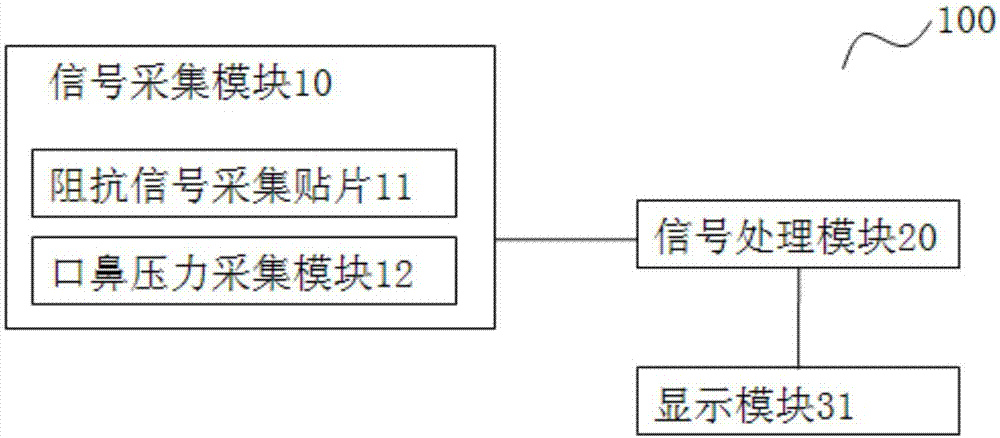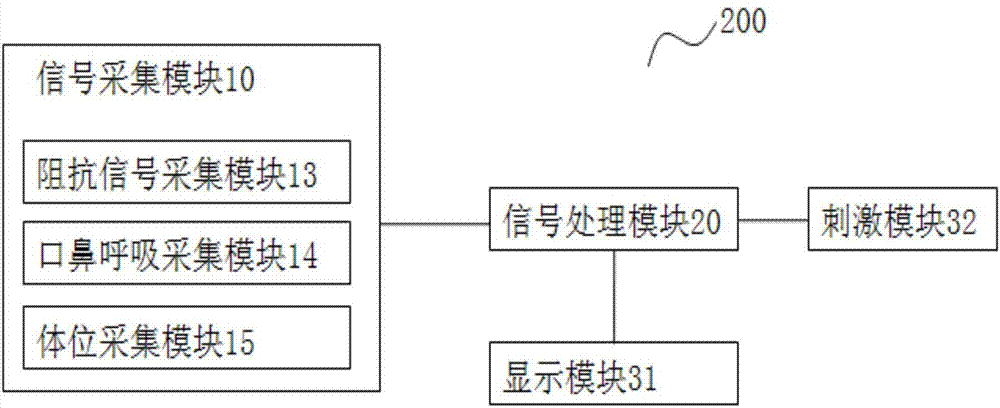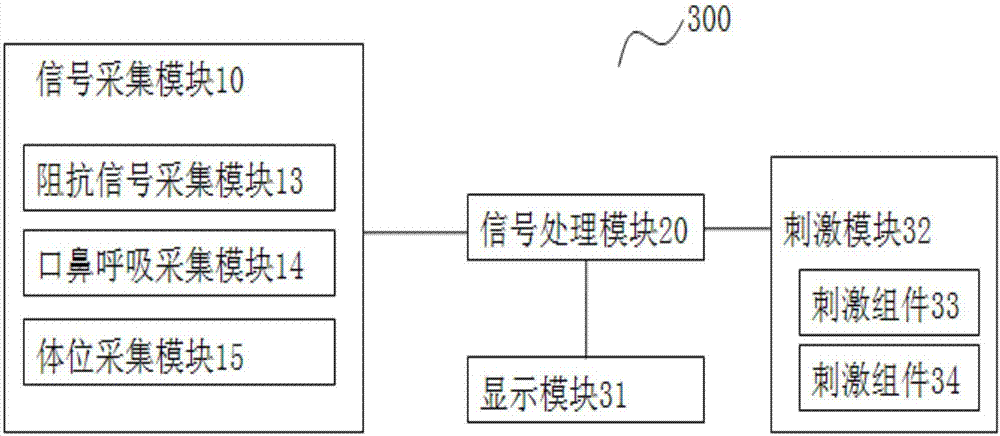System and method for monitoring and treating sleep apnea syndrome
A technology for sleep apnea and syndrome, applied in the field of medical monitoring, can solve the problems of increasing equipment costs, achieve the effect of low cost, simple system structure, and reduce the recurrence of apnea events
- Summary
- Abstract
- Description
- Claims
- Application Information
AI Technical Summary
Problems solved by technology
Method used
Image
Examples
Embodiment 1
[0017] figure 1 It is a schematic diagram of a system for monitoring and treating sleep apnea syndrome according to the present invention. The system 100 includes a signal acquisition module 10, a signal processing module 20, and a display module 31, wherein the signal acquisition module 10 includes an impedance signal acquisition patch 11 and Oral and nasal pressure acquisition module 12. The impedance signal acquisition patch 11 is attached to the chest and abdomen of the human body, and is used to collect the respiratory movement signals of the chest and abdomen. The electrode sheet is used for impedance signal acquisition, which is convenient to use, does not affect the normal sleep of the user, and avoids the inconvenience caused by the use of traditional chest and abdomen belts. At the same time, it also avoids the impact on the accuracy of the test results caused by the tester's improper adjustment of the tightness of the chest and abdominal belt. The mouth and nose pr...
Embodiment 2
[0019] Figure II Another schematic diagram of the system of the present invention, the system 200 includes a signal acquisition module 10, a signal processing module 20, and a display module 31, wherein the signal acquisition module 10 includes an impedance signal acquisition module 13 and a mouth and nose breathing acquisition module 14, and also includes a module for Stimulate the user's stimulation module 32 and body position detection module 15, wherein the body position detection module 15 usually uses an acceleration sensor to monitor the user's sleeping position and sends the body position signal to the signal processing module 20. The stimulation module 32 is preferably a vibration module, and the vibration module has multiple vibration modes, which are controlled by the signal processing module 20, including low frequency and high frequency. The signal processing module 20 sends different commands to the stimulation module 32 according to different types of apnea eve...
Embodiment 3
[0021] attached image 3 It is a schematic diagram of a system 300 similar to Embodiment 2, with Figure 4 It is a schematic diagram of wearing the system 300 of this embodiment. Impedance signal acquisition module 13 is two electrode sheets attached to the chest and abdomen; signal processing module 20 and body position acquisition module 15 are located in a host 40, which is also provided with display module 31; mouth and nose breathing acquisition module 14 includes mouth and nose The air flow pipe and the pressure sensor located at the host 40 interface.
[0022] The stimulation module 32 includes a stimulation component 33 and a stimulation component 34, wherein the stimulation component 33 is a vibration patch or a stimulation electrode or other similar ones, which act on the throat of the human body, and it can prompt the user to produce a swallowing action and then open the breath during operation. Airway; stimulating component 34 can produce the same or different ty...
PUM
 Login to View More
Login to View More Abstract
Description
Claims
Application Information
 Login to View More
Login to View More - R&D
- Intellectual Property
- Life Sciences
- Materials
- Tech Scout
- Unparalleled Data Quality
- Higher Quality Content
- 60% Fewer Hallucinations
Browse by: Latest US Patents, China's latest patents, Technical Efficacy Thesaurus, Application Domain, Technology Topic, Popular Technical Reports.
© 2025 PatSnap. All rights reserved.Legal|Privacy policy|Modern Slavery Act Transparency Statement|Sitemap|About US| Contact US: help@patsnap.com



